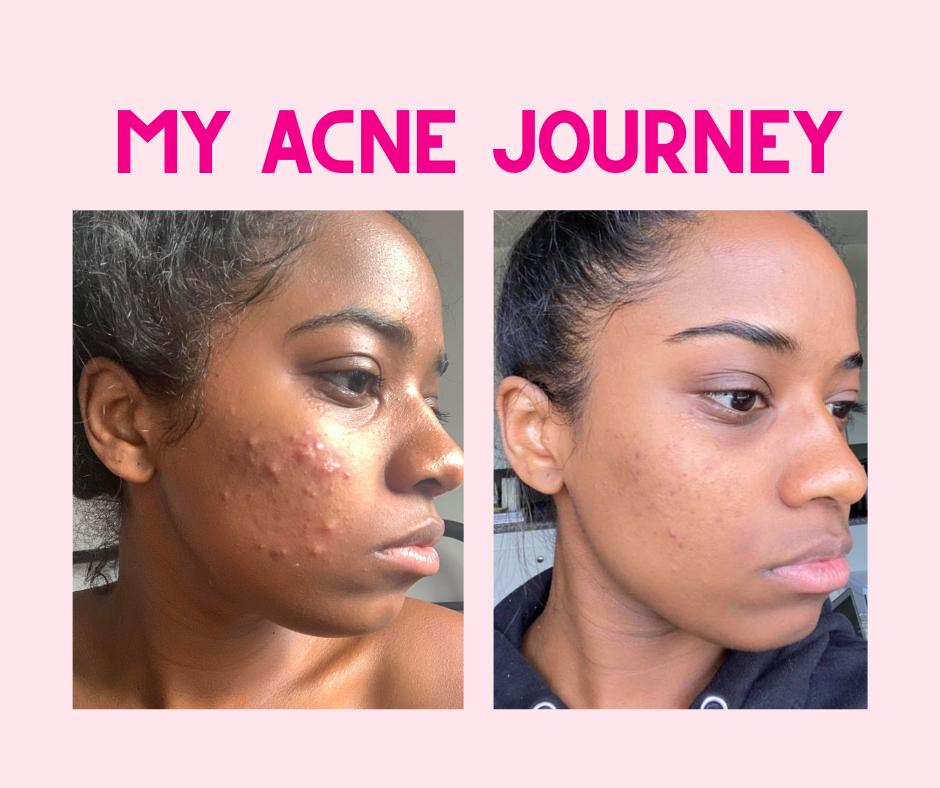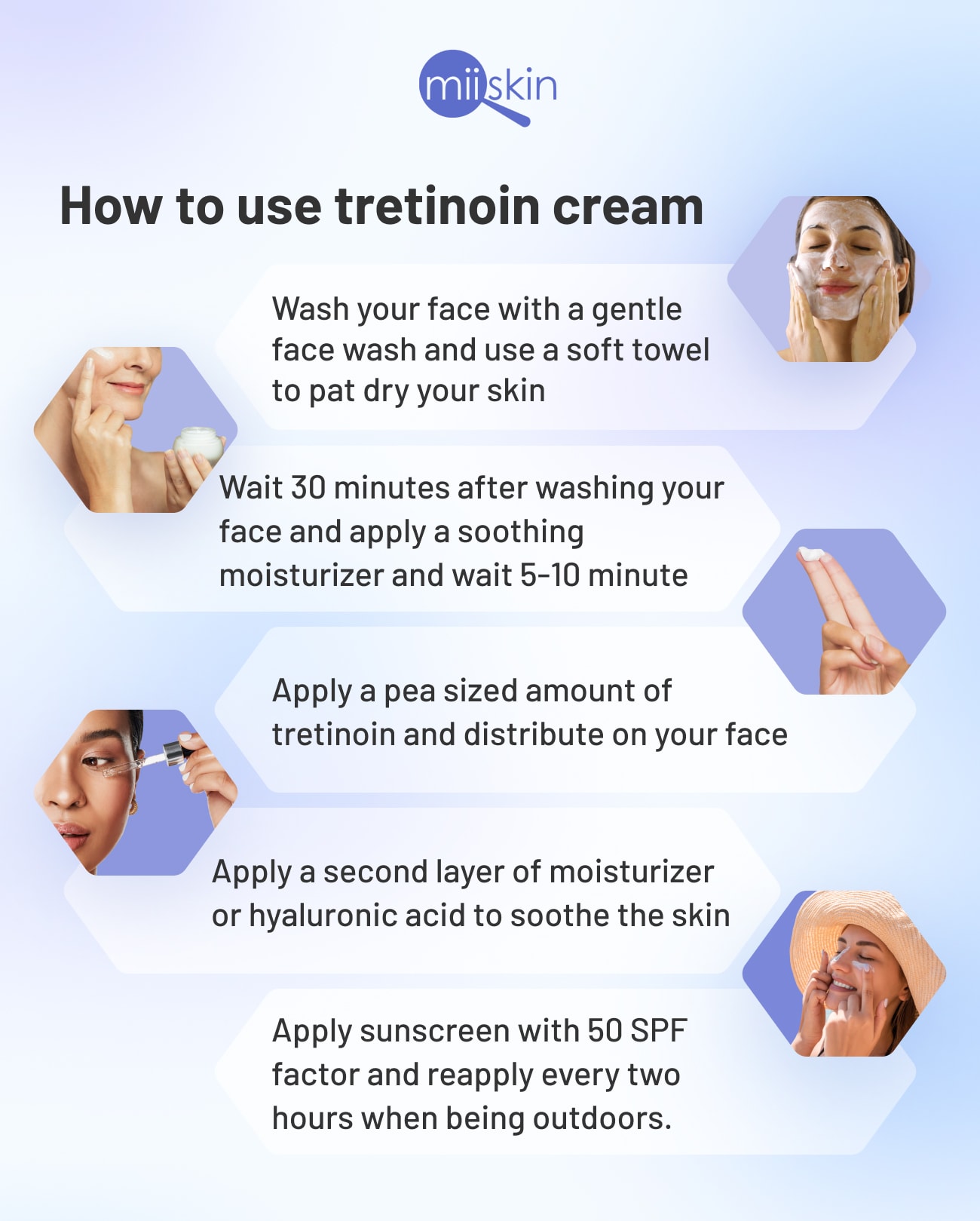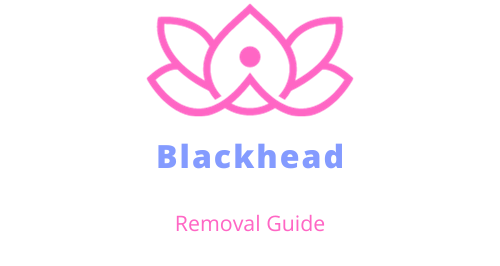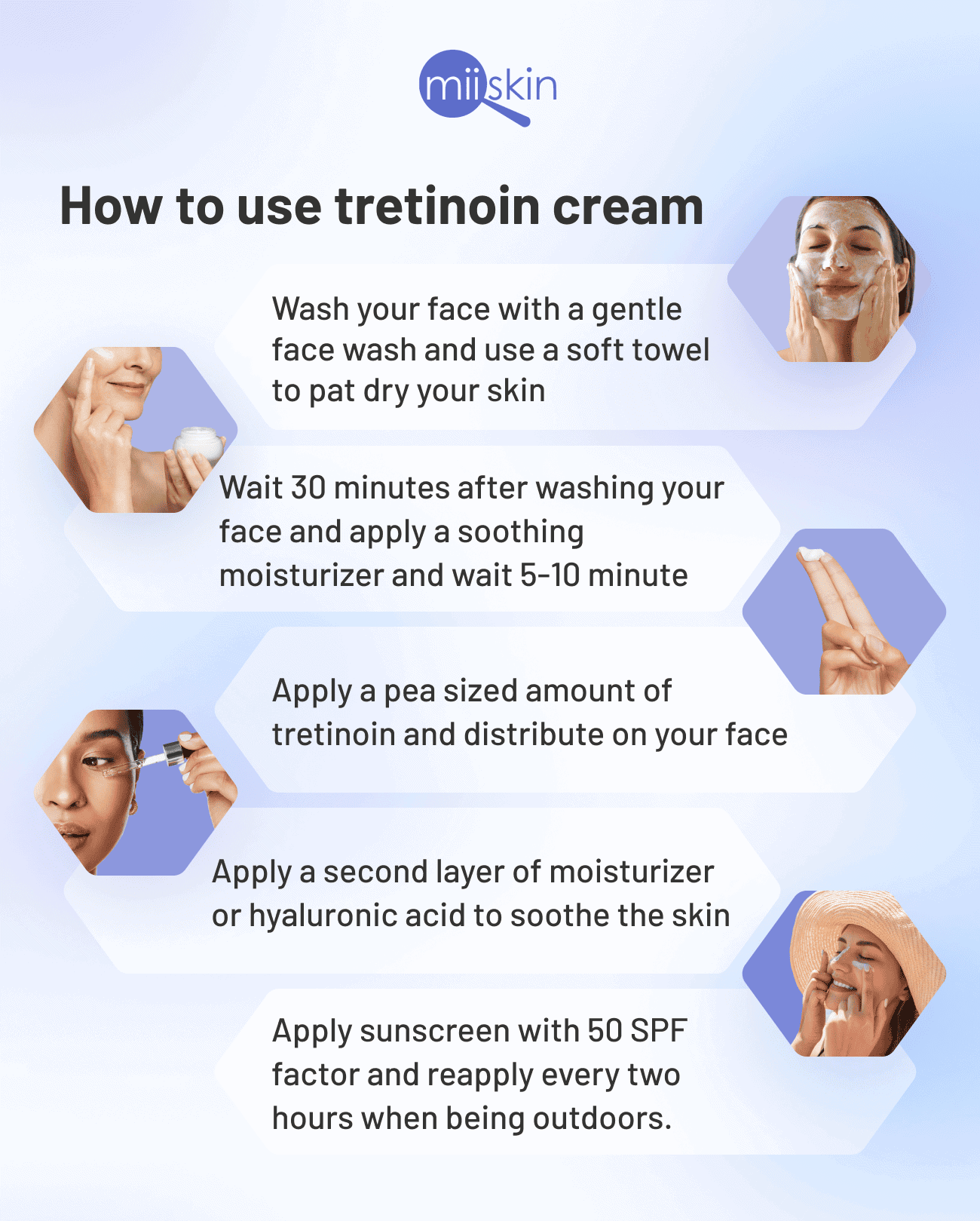To effectively use tretinoin for acne, apply a pea-sized amount to clean, dry skin at night. Avoid overuse and sun exposure, and use a moisturizer to combat dryness.
Tretinoin, a derivative of Vitamin A, serves as a potent ally in the battle against acne. Its primary role is to accelerate skin cell turnover, unclogging pores and promoting the reduction of blemishes. Dermatologists often recommend this topical retinoid as part of an acne treatment regimen.
It’s crucial to start with a low concentration, using the medication sparingly to minimize irritation. Consistent nightly application can yield visible improvements, but patience is key — it may take several weeks to notice significant changes. Remember to complement tretinoin therapy with a broad-spectrum sunscreen during the day, as the treatment can increase skin sensitivity to UV rays. Regular consultation with a healthcare provider can ensure the best results and adapt the treatment to your skin’s response.
Introduction To Tretinoin
Tretinoin, a proven acne-fighting medication, has transformed skin care. Derived from Vitamin A, it tackles acne at the source. This topical treatment promotes rapid skin cell turnover. It clears pores and reduces the appearance of acne.
The Role Of Tretinoin In Acne Treatment
Tretinoin works by targeting acne in multiple ways:
- Unclogs pores: It keeps pores clear of blockages.
- Reduces inflammation: It lessens redness and swelling.
- Prevents new acne: Continuous use stops new breakouts.
- Improves skin texture: It smooths the skin’s surface.
Why Tretinoin Stands Out Among Acne Solutions
Tretinoin is unique in its approach to treating acne:
| Feature | Benefit |
|---|---|
| Potent Retinoid | More effective than over-the-counter options. |
| Prescription Strength | Targets severe acne that other treatments can’t. |
| Boosts Collagen | Reduces acne scars and improves skin health. |

Credit: www.healthline.com
Understanding Acne
Acne is a common skin condition that affects millions of people. It can be frustrating and challenging to manage. But with the right knowledge, you can tackle acne head-on. This post will dive into the factors that contribute to acne and its development within the skin.
Factors Contribiting To Acne
Several factors play a role in the emergence of acne. It’s not just about oily skin or bad luck. Understanding these factors can help in managing acne effectively.
- Hormonal changes can stimulate oil production.
- Poor diet might contribute to breakouts.
- Using incorrect skincare products can aggravate the skin.
- Stress can also lead to hormonal imbalances affecting the skin.
- Environmental factors such as pollution and humidity can clog pores.
How Acne Develops In The Skin
Acne development is a process involving multiple steps. Here’s a simplified breakdown.
- The skin produces excess oil (sebum).
- Dead skin cells accumulate and clog pores.
- Bacteria grow in the trapped oil and dead skin.
- The body’s immune response causes inflammation.
- Visible pimples or cysts appear on the skin’s surface.
Addressing these steps is key to managing acne. Tretinoin, a proven acne treatment, works by targeting multiple stages of acne development.
Tretinoin’s Mechanism Of Action
Understanding how tretinoin tackles acne is key to using it effectively. This vitamin A derivative works deep within your skin. It helps clear acne and improve your complexion. Let’s explore its action on the skin and at the cellular level.
How Tretinoin Works On The Skin
Tretinoin speeds up cell turnover. This means that it helps your skin shed dead cells faster. It unclogs pores and makes room for new cell growth. With regular use, tretinoin can reduce acne and smooth out skin texture.
- Reduces fine lines by promoting collagen production.
- Fades dark spots and evens out skin tone.
- Prevents acne outbreaks by keeping pores clear.
Cellular Level Effects Of Tretinoin
On the cellular level, tretinoin works as a powerful exfoliant. It affects the life cycle of skin cells.
| Cellular Effect | Outcome |
|---|---|
| Boosts cell turnover | New, healthy cells replace old ones |
| Increases collagen synthesis | Improves skin elasticity and reduces wrinkles |
| Regulates oil production | Decreases the likelihood of acne |
By influencing how cells grow and die, tretinoin keeps skin fresh and young-looking. It also reduces the impact of acne scars over time.
Starting With Tretinoin
Starting with Tretinoin can be a game-changer for those battling acne. This powerful topical retinoid is known for its effectiveness in renewing skin cells and preventing pore blockage. To ensure a safe and effective journey with Tretinoin, understanding the proper way to begin its use is critical. Let’s dive into how to select the right concentration and apply it correctly to achieve the best results.
Selecting The Right Concentration
Tretinoin comes in various strengths, and choosing the right one is crucial for your skin’s tolerance and the severity of your acne.
- 0.025% – Perfect for beginners or those with sensitive skin.
- 0.05% – A step up for moderate acne or if you’ve used Tretinoin before.
- 0.1% – The highest concentration for persistent, severe acne.
Consult with a dermatologist to determine the best concentration for your skin type and condition.
Initial Application Tips
Applying Tretinoin for the first time requires a careful approach to minimize irritation and maximize benefits.
- Cleanse your face gently with a mild cleanser.
- Wait for about 20-30 minutes after washing to apply Tretinoin.
- Use a pea-sized amount for the entire face, avoiding the eyes and mouth.
- Start slow, applying every other night and gradually increase as tolerated.
Remember, initial redness or peeling is normal. Always use sunscreen during the day while using Tretinoin.
Application Techniques
When tackling acne, tretinoin can be a game-changer. Using the right application techniques is crucial for success. Let’s dive into the methods that ensure tretinoin works effectively on your skin.
Best Practices For Tretinoin Application
- Start with clean skin: Wash your face gently and pat dry.
- Pea-sized amount: Use just enough to cover the entire face lightly.
- Even distribution: Apply in dots around the face, blend evenly.
- Timing matters: Wait 20-30 minutes after washing your face to apply.
- Be patient: Results can take several weeks to show.
Avoiding Common Application Mistakes
| Mistake | Correction |
|---|---|
| Using too much | Stick to a pea-sized amount for the entire face. |
| Applying on wet skin | Ensure skin is fully dry to prevent irritation. |
| Skipping sunscreen | Apply broad-spectrum SPF 30+ daily. |
| Ignoring irritation | Use every other night if you notice redness or peeling. |

Credit: www.mixedmakeup.com
Managing Side Effects
Tretinoin, a potent acne-fighting medication, can transform your skin. But, it may come with side effects. Let’s manage them effectively.
Identifying Potential Side Effects
Knowing what to expect helps you prepare. Tretinoin may cause:
- Redness
- Peeling
- Dryness
- Sensitivity to sunlight
Mitigation Strategies For Side Effects
Minimize discomfort and keep skin happy with these tips:
- Start Slowly: Use tretinoin every other night.
- Mild Cleanser: Pair with a gentle face wash.
- Moisturize: Apply a hydrating cream after tretinoin.
- Sun Protection: Wear sunscreen daily.
Side effects usually subside after a few weeks. Stick with it for clear skin!
Combining Tretinoin With Other Treatments
Combining Tretinoin with Other Treatments can be a game-changer for acne management. Tretinoin, a form of vitamin A, promotes skin cell turnover and prevents pore clogging. But it doesn’t work alone. Integrating other products can enhance its effectiveness. This section explores how to safely mix tretinoin with additional treatments for maximum results.
Synergistic Acne Treatment Approaches
A synergistic approach means using products that work together to improve acne. Here are some proven combinations:
- Benzoyl Peroxide: Kills bacteria and can be used in the morning.
- Moisturizers: Hydrate the skin and reduce tretinoin irritation.
- Sunscreen: Protects skin, as tretinoin increases sun sensitivity.
Remember to introduce new products slowly. Start with tretinoin, then add others one by one.
What To Avoid Mixing With Tretinoin
Certain products shouldn’t mix with tretinoin. Here’s what to avoid:
- Exfoliating Acids: Such as glycolic or salicylic acid may cause irritation.
- Vitamin C: Can be unstable and less effective with tretinoin.
- Certain Medications: Always consult a doctor before combining treatments.
Use one active ingredient per routine to prevent overloading your skin.

Credit: miiskin.com
Lifestyle Factors And Tretinoin Efficacy
Tretinoin is a powerful tool in the fight against acne. But for the best results, it’s essential to consider lifestyle factors. These factors can influence tretinoin’s effectiveness. Let’s explore how diet, stress, and sleep can impact your journey with tretinoin.
Diet And Tretinoin Success
What you eat matters for skin health. A diet rich in vitamins and antioxidants can boost tretinoin’s power. Here are some key nutrients to focus on:
- Vitamin A: Supports skin repair and reduces inflammation.
- Vitamin C: Helps in collagen production and skin healing.
- Vitamin E: Protects skin cells from damage.
- Zinc: Heals skin and reduces oil production.
Include foods like carrots, spinach, oranges, and almonds in your diet. These can work alongside tretinoin to enhance your skin’s appearance.
The Impact Of Stress And Sleep On Tretinoin Usage
Stress and sleep affect skin health. They can alter how well tretinoin works for you. Here’s what to keep in mind:
| Factor | Impact on Skin | Tips |
|---|---|---|
| Stress | Increases acne breakouts | Try relaxation techniques like yoga or meditation. |
| Sleep | Allows skin to heal and rejuvenate | Aim for 7-9 hours of quality sleep each night. |
Manage stress with regular exercise and ensure you get enough sleep. Your skin, along with tretinoin, will thank you.
Monitoring Progress And Adjusting Usage
Monitoring Progress and Adjusting Usage is crucial when tackling acne with tretinoin. As your skin adapts, changes may occur that call for alterations in your skincare routine. Let’s dive into how to effectively track these changes and know when it’s time to tweak your tretinoin dosage.
Tracking Skin Changes Over Time
Observing your skin’s response to tretinoin is key. Keep a skin diary or take weekly photos to monitor improvements or any new concerns. Look for reduced inflammation, fewer breakouts, and changes in skin texture. Note any side effects, like dryness or peeling.
- Redness
- Peeling
- Breakouts
- Texture
When To Adjust Tretinoin Dosage
Adjusting the tretinoin dosage may be necessary for optimal results. Seek guidance from a healthcare provider if severe irritation occurs. Consider the following reasons for dosage adjustments:
| Reason for Adjustment | Action to Take |
|---|---|
| Excessive Dryness | Reduce frequency |
| Peeling Skin | Apply every other night |
| Persistent Irritation | Consult with a dermatologist |
| Improved Skin with No Side Effects | Maintain current regimen |
Success Stories And Testimonials
Welcome to the inspiring world of tretinoin success stories. These real-life experiences and insights can guide newcomers through their acne treatment journey with tretinoin. We have gathered testimonials and pieces of advice from individuals who have seen their skin transform. Their shared wisdom serves as a beacon for those about to embark on this path.
Real-life Tretinoin Transformations
Meet the individuals who battled acne and won, thanks to tretinoin. Their stories shine with triumph over stubborn skin issues. Each transformation is a testament to the effectiveness of this powerful retinoid.
- Jane’s Journey: Six months in, her cystic acne faded, revealing clear skin.
- Mark’s Milestone: Persistent pimples gone, confidence restored after a year.
- Emma’s Evolution: Smoother skin texture and reduced scarring within nine months.
What Users Wish They Knew Before Starting
First-time users of tretinoin often wish they had insider knowledge. Here is a list of what seasoned users wish they knew before they started their treatment:
| Advice | Reason |
|---|---|
| Start Slowly | Prevents skin irritation and peeling. |
| Moisturize | Keeps skin hydrated and reduces flakiness. |
| Patience is Key | Results can take several weeks to appear. |
| Sun Protection | Prevents sun damage, as tretinoin increases sensitivity. |
Conclusion: Embracing The Journey To Clear Skin
Dealing with acne is not just about quick fixes. It’s about embracing a journey. A journey that involves patience, persistence, and the right skincare routine. Tretinoin, a proven acne-fighting ingredient, can be a game-changer on this path. Let’s conclude by looking at how to stay committed and what to expect in your quest for clear skin.
Patience And Persistence With Tretinoin
Starting tretinoin can feel like a leap of faith. It takes time to work. Skin might get worse before it gets better. This is normal. Don’t give up. Here’s what to keep in mind:
- Stick to the plan: Use as directed by your doctor.
- Expect changes: Initial irritation is common. Your skin will adjust.
- Be consistent: Apply tretinoin regularly for best results.
- Track progress: Take photos to monitor improvements over time.
Final Thoughts On Achieving Acne-free Skin
Clear skin is a realistic goal with tretinoin. Remember these key points:
| Tip | Reason |
|---|---|
| Less is more | Too much can irritate the skin. |
| Patience pays | Results can take a few weeks to months. |
| Sun protection | Tretinoin makes skin sensitive to the sun. |
| Stay hydrated | Moisturize to combat dryness. |
Remember, every journey starts with a single step. Your commitment to using tretinoin can lead to the clear skin you desire. Stay positive, and trust the process!
Frequently Asked Questions
How Long Does It Take For Tretinoin To Clear Acne?
Tretinoin may start improving acne within 2-3 weeks, but it can take up to 12 weeks to see full results. Consistent use is key for the best outcomes.
What Is The Most Effective Way To Use Tretinoin?
To effectively use tretinoin, start with a pea-sized amount at night, apply to dry skin after cleansing, and always use sunscreen during the day. Gradually increase frequency as tolerated, and consult a dermatologist for personalized advice.
Do You Put Tretinoin On Before Or After Moisturizer?
Apply tretinoin to clean skin before moisturizer. Allow it to absorb for 20-30 minutes, then follow with your moisturizer to reduce dryness.
How To Apply Tretinoin For Acne?
To apply tretinoin for acne, start with clean, dry skin. Apply a pea-sized amount at night, avoiding the eyes and mouth. Spread it gently across affected areas, using it consistently as directed by your dermatologist. Avoid sun exposure and apply sunscreen during the day.
Conclusion
Navigating the path to clear skin is simpler with tretinoin as your ally. By sticking to a consistent routine and following expert guidance, you can effectively harness its benefits. Remember, patience and persistence are key to seeing a transformation. Embrace tretinoin’s power for a smoother, acne-free complexion.

